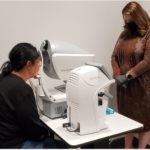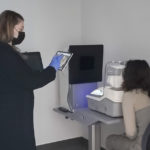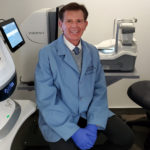
A patient in Dr. O’Connor’s office gets screened using the Visionix® VX120+ with Dry Eye screening.
Sponsored Content
By Gregory O’Connor, OD
June 9, 2021
Like most optometrists, I want to provide patients with the latest advancements in vision care while growing my patient base and profitability. I have added emerging technologies to my practice that allow me to do just that. Here are the details on the technologies, the Visionix® VX40 lens analyzer, the Visionix® Eye Refract and the Visionix® VX120+ with Dry Eye screening, that have made such a positive difference to my patients and my practice’s financial strength.
Live Up to Your Practice Mission with the Right Technology Investments
Our practice mission is to provide people seeking eyecare the finest environment, staffing and technology with a minimum of hassle. To that end, we strive to give each patient a custom experience tailored to their specific needs and tastes. Visionix® technologies help us accomplish this goal of delivering advanced, custom care.
A Next-Generation Suite of Technologies
The VX40 and Eye Refract work together seamlessly to provide a higher level of care for patients.
Wavefront lens analysis, a unique feature in VX40, maps out the optics of a lens on a color touchscreen that gives me and my staff much more information than the standard lensometer findings, particularly regarding a progressive addition lens. Its ease of use is a delight, as you simply insert the eyeglasses into the holder and push a button to get the results, which then transfers automatically to the Eye Refract. Such simplicity makes it a breeze to train new staff.
The lens analyzer dramatically improves the accuracy and efficiency of neutralizing a patient’s eyeglasses, checking the accuracy of newly delivered glasses from the lab, troubleshooting non-adapts and similar issues.
What is most unique about the Eye Refract is Physiological Refraction. It is an automated binocular refractive instrument, powered by an algorithm-guided program which can handle even pupils below 3mm, and has an elegant and compact design. It uses dual Shack-Hartmann wavefront aberrometers in conjunction with the VX40 Powermap Wavefront Technology, to refract 1500 points in each lens simultaneously. The findings are immediately sent to the Eye Refract device which can be controlled remotely with a tablet. The manifest refraction is conducted in a scripted step-by-step method assessed by an algorithm to render the most precise result possible. These features make it easy for a technician to confidently collect refraction data—and is quite impressive for the patient.

A technician in Dr. O’Connor’s practice owns the refraction data collection process with the Visionix® Eye Refract
The Eye Refract is incredibly advanced compared to anything most patients have experienced in their eye exam. Typical patient comments after experiencing refraction with the Eye Refract:
“I’m never getting an eye exam anywhere else!”
“I have to make appointments for my family.”
And after capturing an image on the smartphone, “I’m going to share my experience with my friends.”
Not surprisingly, these highly favorable responses drive many new patients to my practice.
Taking Dry Eye Diagnosis to the Next Level
Another advanced technology from Luneau Technology that we use for patients and practice growth is the multi-modal Visionix anterior segment analyzer or VX120+DE.
The VX120+ with Dry Eye screening combines eight instruments into one multi-function unit that features fully automated 3D alignment, tracking and focusing for both eyes with a 10.4-inch color touchscreen. These eight instruments include: Shack-Hartmann wavefront aberrometer, a Scheimpflug pachymeter, a 100,000-point corneal ring topographer, wavefront autorefractor, autokeratometer, non-contact tonometer, an anterior segment analyzer and a dry eye module. Within a few minutes, in a manner comfortable for the patient, it gathers a wealth of diagnostic information that is instantly conveyed to me where I need it, so that I can provide easy consultation with my patients
The Dry Eye module features an anterior segment camera that yields pictures of the eye and adnexa, clearly demonstrating tear meniscus height, blepharitis, MGD and a video of the tear break-up pattern over time. The resulting images make it easy for the doctor to demonstrate to the patient any problem and document the progress of the therapy.
Let Patients See for Themselves
My patients deserve the best, and that includes high-performing technology that makes refraction less stressful for patients, and an efficient screening process allows me to spend more time on patient education and counseling. Seeing the results from imaging using the VX120+ with Dry Eye screening compels the patient to act and be more involved in their care. With the visuals and reports I am able to present, they can immediately see if there is a change in their prescription.
We offer a full range of dry eye therapy treatments and products that are often purchased out of convenience. I would estimate that the new patients attracted would yield a growth of practice revenue annually of at least $100,000.
The difficulty for anyone not using imaging systems to capture diagnostic findings is that, regardless of the acumen of the practitioner, conveying the problems detected are difficult for the patient to grasp. If a picture is worth a thousand words, that fact translates into thousands of dollars for the practitioner using the Visionix technologies.
 Gregory O’Connor, OD, is the owner of Malibu Eye Center Optometry in Malibu, Calif. To contact him: drgregoconnor@hotmail.com
Gregory O’Connor, OD, is the owner of Malibu Eye Center Optometry in Malibu, Calif. To contact him: drgregoconnor@hotmail.com

























